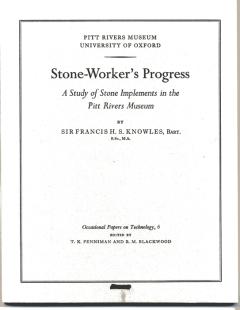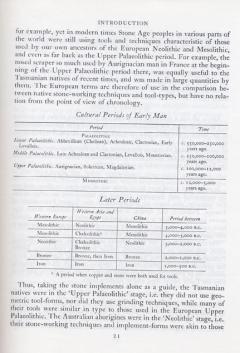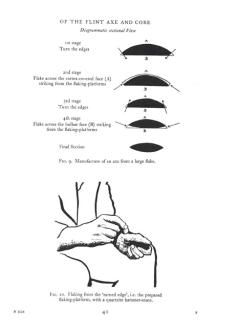ENGLAND: THE OTHER WITHIN
Analysing the English Collections at the Pitt Rivers Museum
A stone-worker's progress: Francis Knowles' last publication
Alison Petch,
Researcher 'The Other Within' project
In the same year that he died (1953), Francis Knowles' second Occasional Paper on Technology was published, 'Stone-workers' Progress: A study of stone implements in the Pitt Rivers Museum'. This was the sixth occasional paper to be published. Unfortunately, he did not live to see the publication as he died before the proofs could be prepared. [p. 10]In the preface, the editors (Penniman and Blackwood, again) explained that Knowles 'has long been associated with the gun-flint makers of Brandon in Suffolk, and has for many years been making stone implements with the simple tools used by ancient and modern Stone Age peoples. At the Curator's request he undertook the teaching of Stone Age techniques in the Museum, and in the course of teaching prepared a series of exhibition cases with explanatory screens representing the principal ancient and modern Stone Age implements and the methods of making them. At the same time he prepared a manuscript book, which has been used for some years in teaching our pupils who study Ethnology and Prehistory. It is this book we offer as Number 6 in our Occasional Papers ... as we have found over a long time that his method of exactly describing experimental procedure and following this with literary example from various observers is useful to students. Examination of specimens is confined to our own large collection, so that students can check every detail described.' [p.3]
The difference between his first Occasional Paper and second was that the second was more wide-ranging: 'the author does not restrict himself to one subject as in the former paper, but treats the progress of the stone implement maker from ancient to modern times in both the Old World and the New, dealing with the principal types of flaked implements'. [p. 3]
In the Foreword, the early beginnings of stone-working are explored:
in the striking of flakes from flint and other siliceous stone, it is likely that the first attempts made by man were to make sharp and durable implements. It is because of the very durability of these tools that they will often be the only evidence still left of man's progress in intelligence and skill, from the early days of tool-making to the time, before metal superseded stone, when the latest examples of his work show the advances he had made in technical achievement. We, viewing a representative collection in a museum, can look back and see telescoped, as it were, a vast period of time and development. To us the forward steps seem obvious. But the early stone-worker had not our advantage of seeing what lay ahead; he could only build little by little on the store of technical tradition passed on from one generation to another. [p.10]
Although, by the period known as the neolithic, Knowles points out that people had worked out how to work stone by pecking, grinding, sawing and boring, most stone-workers stuck to flint:
Taking a general view of the Stone Age, the complexity of flint tools and their specialization in type went hand-in-hand with changes and improvements in flaking methods, and show the increasingly complexity of Man's life, his restless inventive genius and his technical progress. [pp. 13-14]
Knowles announced that his intention in the book was to confine it to 'the flaking of siliceous stone in the manufacture of the axe, spear-point, knife, and arrow-head, and the core from which flakes were struck to make tools.'. He would take 'some account ... of recent Stone Age native peoples, for the light these throw on the methods used by prehistoric peoples in the manufacture of similar flint weapons and tools'. [p.14]
In other words the book was based upon '1. Experimental work 2. A study of the stone-implement collections in the Pitt Rivers Museum 3. The technical methods of the recent native stone-worker as recorded in literature by European observers'. [p. 17]
Interestingly, Knowles bothered to define what he meant by technical progress:
'Stone working is the adventure of Man with a material, stone, from which he wanted to make some of his tools and weapons. 'Progress' then to the stone-worker will mean better ways of dealing with stone, and better and more efficient implements made from it. It is in this sense that the words 'advance' and 'progress' are used by the writer, and his point of view is that of the experimental worker.' [p17]
Towards the end of the book, Knowles turns towards a consideration of changes in technique and the 'underlying idea in technical methods':
In a representative museum collection of flint implements from early to late periods, time and development are foreshortened, and changes which took many hundreds and thousands of years to develop appear to have arisen in the space of one exhibition case to another. Yet many must have been the slight changes in the accepted techniques of the time, some perhaps due to accident owing to the material used and its shape in its raw state, some to the individual variations inherent in a handicraft, and some due to the experimental genius of the individual worker seeking to better the standard methods, before the underlying idea in the stone-working methods of the period became changed, a new idea considered an improvement on the old one accepted, and a new technique born. Inventive genius must have been stimulated and new ideas called forth by new wants brought into being by changes in living conditions due to climate, new environment, or survival in the face of the hostility or competition of other peoples. All these causes might well evoke new or improved ways of dealing with wood, antler and other materials in general use, necessitating new forms of stone tools, or urge the need for new and improved forms of stone implements to arm new or improved weapons. ... it seems reasonable to suppose that technical equipment developed little by little in the manner indicated above. Otherwise the civilized and metal-using peoples of later times would never have emerged from the Stone Age peoples of the world, and there would have never have been any technical advance anywhere. [p.101]
He then considers the plight of 'Tasmanian Aborigines' and 'South African Bushman' before considering an example of technical advance: the core technique:
Perhaps of all stone techniques the core technique, whereby the worker obtained his essential flake-tools, best shows the change of thought and practice that, from a general and universal point of view, added to the techniques of the stone-worker. The earliest core technique represented in the Pitt Rivers collections is that of the Clacton and Clacton-type. In this technique the worker used flattened nodules or pieces and struck off flakes from the edges in the obvious and easy way. This is probably the earliest core technique, yet one that was always found useful at times and places in stone-working, even in the latest Stone age times.
Gradually the worker found that it was possible to form the shape of the flake he wanted on one face of the mass of the stone he was using as a core, instead of going on striking rather clumsy flakes from the edges of the piece. At the back of his quest for a particular flake there must have been a number of compelling factors and the urge for a symmetrical flake of some needed form. Eventually he found that by improving on this technique by using different forms of core, he could obtain a number of different forms and sizes of flake-implements. Thus in the full development of the 'tortoise'-type core a very efficient form of flake and flake-implement technique was established, was widespread, and was characteristic of what may be called the Middle Palaeolithic period.
Then the urge arose for symmetrical flakes, narrow in proportion to their width, in different sizes, and capable of being produced in large quantities, and the Brandon-type and double-platform cores were the answer, for the requisite single-ridged and double-ridged flakes could be produced in large numbers from a suitably shaped core of either of these kinds, with the minimum of waste material, or a core of this kind could be kept, from which a fresh knife could be struck whenever the one in use became blunted, until nothing was left but a waste core to be discarded, while a fresh one took its place.
Now some forms of 'tortoise'-core were at their opening stages Brandon-type cores in being, and the double-platform core is plainly developed from a form of double-platform 'tortoise'-type core, so that the underlying idea in the stone-worker's mind had only to work in its development from one form of core to another. Yet the change is complete and final, and the 'tortoise'-type core is not to be found in the later prehistoric Stone Age, nor in the modern Stone Age industries of our own time ...
The changes themselves must have led to the search for material of suitable shape and quality, and so on to the later development of mining for siliceous stone. Improvement of one kind led to improvements in another, and to an ever-widening and increasing flow of needs accompanied by the means to satisfy them.
In the implement itself, the Lower Palaeolithic hand-axe shows the idea working in the variation from the essential and characteristic pear-shaped chopping and piercing instrument, a general purpose tool, to the chopper, cleaver, and dagger-shaped forms of the late Acheulean period, and so on to the chopping implements, and possibly indirectly to the axes and adzes of modern Stone Age peoples.
The flake develops into a number of implements for specialized purposes, and in time, when the bow is invented, may become the symmetrically flaked stone arrow-head of the Neolithic and later period.
The flaked spear-point and knife develop into the beautiful Egyptian Predynastic chert ripple-flaked knife, the Danish handled and fluted-flaked flint dagger, and the magnificent American Indian flaked knives, all three types the artistic and technical masterpieces of Man's work in flaking stone. [pp. 103-5]
To conclude, Knowles says:
Flint, and other stone, make the most durable of Stone Age Man's tools and implements. The flakes struck off in the making of a flint implement show by the direction of the flake-scars the intention and skill of the man who shaped the piece of flint. The way in which the flake-scars are made, the technique, shows the degree of the worker's skill, intelligence and knowledge of his material, while the form and variety of the implements themselves, among peoples who make considerable use of flinty material, may show the complexity of the worker's life, the cultural level to which he has attained, and his artistic feeling for beauty of shape and surface pattern.
It is therefore for the light they throw on the developments of Man that so much interest lies in the study of stone implements, for their increasing fineness and complexity through the time periods shows the developing fineness and complexity of the mind of their users; the advance of technical methods shows the gradually acquired mastery of the material by means of experiment and inventive genius, and artistry and craftsmanship are shown in the shaping by skill of hand a difficult, often beautiful material.
It is necessary to stress at this point the early date at which fine craftsmanship was shown by Stone Age Man, for even as far back as the Lower Palaeolithic the large finely made Acheulean-type hand-axes are, in their shape, symmetrical section, and the pattern of their cross-flaking, superb examples of skill in flint-flaking. Later, in the French Solutrean period of the Upper Palaeolithic, yet still remote in point of time, the large leaf-shaped flaked-points are, in their width, thinness of section, and the symmetrical cross-flaking of their surfaces, among the finest products of the flint-flaker at any date. Their size and thinness must have necessitated careful handling, and it may be that some mining experience was needed to find seams that would supply nodules of a shape that would lend itself to the manufacture of these wonderful examples of flint-work.
Surveying stone-working as a whole, the significant advance in the later periods was the invention of techniques that enabled the worker to use unflakeable stone. Nevertheless, flint was always in use where it was plentiful and of good quality, and in those areas the later stone-worker with his advanced technical knowledge and specialized skill was able to manufacture flaked-implements of a perfection of shape and flaking-pattern that could not have been achieved by his distant ancestors.
The flaked-flint implement is an object of interest because of its material, symmetry of form, and flaking-pattern, and because of the technique of its manufacture. It has also the romantic association of places and times far off and long ago. But it is, above all, the very lasting evidence of the skill, inventiveness, and artistry of the Stone Age Craftsman.
Chapters of the Stone-worker's Progress
Chapter 1: Selection to illustrate flaking techniques: The 'axe', spear-head, knife, arrow-head, and core
Chapter 2: Technical problems
Chapter 3: Technical developments in the manufacture of the flint axe and core.
Chapter 4 a. Technical development in the manufacture of the flaked point used as spear-head, knife, or arrow-head
Chapter 4 b. Technical variations in the manufacture of the flint spear-head and knife among modern Stone Age Native peoples
Chapter 5: Flaking with a quartzite pebble and other hard hammer-stones
Chapter 6: Flaking with 'soft' hammers
Chapter 7: Flakes and hammers
Chapter 8: The tools used in flaking-work by modern Stone Age peoples
Chapter 9: The flint-worker himself
Chapter 10: The flint-worker's material
Chapter 11: Change in technique and the underlying idea in technical methods
Chapter 12: Flint-work and the flint-worker
Johnson in 1978 comments of this work:
Knowles's introduction to he collection of stone tools at the Pitt-Rivers [sic] Museum is an excellent follow-up to Knowles (1944) giving precise directions to the manufacture of other bifacial tools and aimed at answering the questions "how far advanced in techniques was the stone-worker who struck off the flake, what tools did he use, and what was his range of methods". [Johnson, 1978: 350]
Further Reading
Johnson, L. Lewis et al. 1978. 'A history of flint-knapping experimentation 1838-1976' Current Anthropology, vol. 19 no. 2 (June 1978) pp. 337-372


